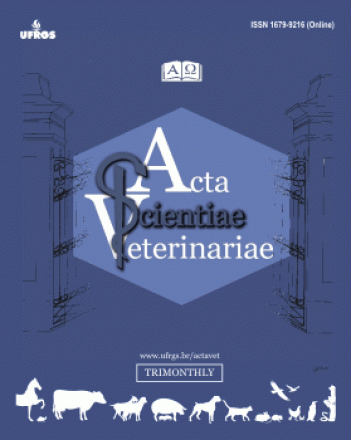Linfadenite caseosa em ovinos abatidos sob inspeção federal no estado do Rio Grande do Sul - estimativas de perdas
Acta Scientiae Veterinariae
Linfadenite caseosa em ovinos abatidos sob inspeção federal no estado do Rio Grande do Sul - estimativas de perdas
Autor Correspondente: Gustavo Machado | [email protected]
Palavras-chave: corynebacterium pseudotuberculosis, linfadenite caseosa, condenação de carcaças, matadouros, ocorrência, prejuÃzos econômicos
Resumos Cadastrados
Resumo Inglês:
Background: Caseous lymphadenitis (CL) is considered one of the most important diseases, economically, in sheep and goats
in the United States, Canada and Australia. Annual losses in wool production reaches 17 million dollars in Australia, the disease
cause important impact in Europe, Africa, Middle East, Australia, and in the Americas. The CL is a chronic disease, which affects
mainly sheep and goats. The etiologic agent is the Corynebacterium pseudotuberculosis. The presence of the agent in feces
contributes to environmental contamination and increases the risk of infections in herds. For countries with international
marketing of live animals, the CL is a serious health problem to livestock disease-free. The objective of this study was to report
the occurrence of lesions caused by CL in sheep slaughtered under the official service of inspection of the state of Rio Grande
do Sul and correlate it to the economic losses due to the lesions found.
Materials, Methods & Results: Data concerning the fate of raw materials, the total number of animals slaughtered and injuries
from the ante and post-mortem were provided by the Federal Inspection Service (SIFs do Ministério da Agricultura, Pecuária e
Abastecimento no Rio Grande do Sul (SFA/MAPA-RS). Data from the slaughtered animals were generated by the information
system management service inspection (SIGSIF), requested in official character, which included the daily slaughter maps, as well
as monthly and annual reports. Were collected data from 932,547 sheep slaughtered under federal inspection, from January 2004
to August 2009. The number of cases recorded only in Federal Inspection Service was 348 and the number of animals condemned
at slaughter was 86. Through assigning an average weight of 17,57 kg per carcass value of 8.50 kg-1 of carcass based in the
literature, the estimated direct economic losses caused by lesions of CL in the period relating to the condemnation of carcasses
in slaughter plants under federal inspection was R$ 12.975,27(US$ 7.289,47) (US$ 1,00 = R$ 1.78). Nine hundred and thirty two
thousand and five hundred forty-seven sheep were slaughtered under federal inspection in Rio Grande do Sul in the period from
2004 to 2009, CL occurred on 0,037% of the carcasses (n = 348) and determined the total condemnation of 0,009% (n = 86).
Discussion: The injuries due to CL are significant the cause condemnations of carcasses, the condemnation rate for CL is 3 to 5%
for carcasses of adult sheep on most of the developed countries, on the other hand, in Argentina it had been reported 11% of
condemnation, in Brazil little effort has been done on this way, and the data that are published shows that the Northern part of
the country has been reporting more cases of condemnation due to CL. What is noted in this study is that CL has not been
reported in big amounts in the state, what could lead and give the change of eradication of it from this part of Brazil. The disease
still occurs in sheep in Rio Grande do Sul, it has been found at slaughter by lesions occurred during the whole period from 2004
to 2009, in greater or lesser degree, condemnations and economic losses will continue to be reported while sanitary measures are
not well adopted in Brazil.

